Performance Retrospective: AMD’s Radeon HD 7970M
by Jarred Walton on June 21, 2013 5:25 PM ESTValue/Medium 1366x768 Gaming Performance
We’ll start off with our “Value” settings, which consist of 1366x768 resolution and roughly Medium detail settings in the tested titles. This represents the sort of settings you’d be likely to use on an iGPU like the HD 7660G or Intel’s HD 4000 (maybe—HD 4600 is possibly a better bet) to get a reasonable >30 FPS out of most titles. Several of the games we’re using now are quite demanding, however, so iGPUs may not be able to provide an acceptable experience unless you really turn down the details and resolution. Here’s what performance looks like:
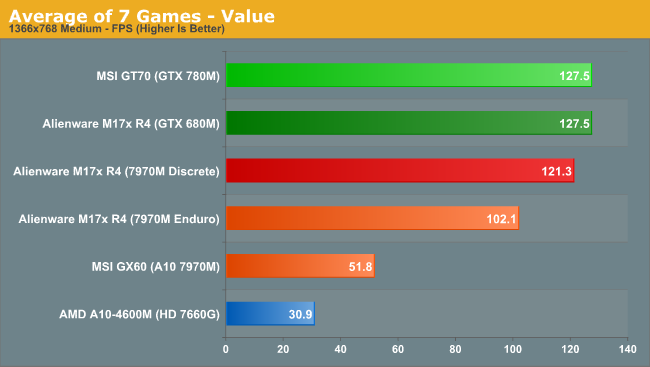

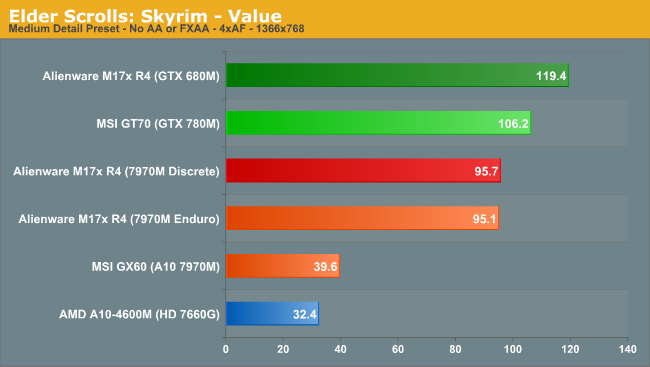

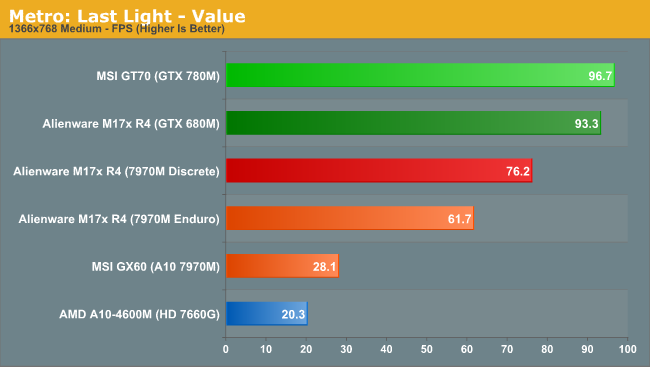

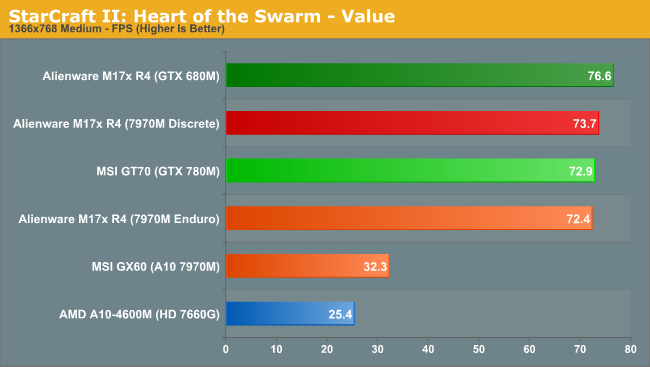
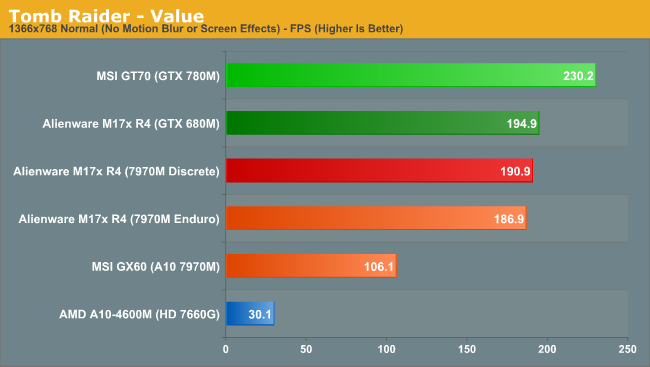
When the HD 7970M first hit notebooks over a year ago, the performance potential seemed lacking compared to the actual hardware. Based on the desktop Pitcairn core, HD 7970M should provide roughly the same performance as the desktop HD 7870 (it’s clocked 15% lower than 7870 on the core, though, so it’s closer to the HD 7850 and GTX 660). The reality is that where the HD 7850 typically competes well against NVIDIA’s desktop GTX 660, on laptops the GTX 680M often blasted the HD 7970M at launch. Many pointed to Enduro as a primary culprit, and while the situation has improved over the past 12 months, even now we can still see a periodic performance deficit from Enduro.
Going over the specifics, on the M17x R4 the discrete mode 7970M ends up being 24% faster in Bioshock, tied in Skyrim, 43% faster in GRID 2, 24% faster in Metro, 54% faster in Sleeping Dogs, tied in StarCraft II, and tied in Tomb Raider. The deficit largely exists in situations where you’re getting >60 FPS, e.g. at lower detail settings and a lower resolution, but that’s obviously not the only factor as Tomb Raider basically elicits no penalty and yet runs at over 180 FPS. While I don’t have the ability to do comparable testing with NVIDIA’s Optimus, I know at one point there were instances where Optimus was slower, but those issues have largely been fixed as far as I can tell. On AMD’s Enduro, that’s clearly not the case with the latest beta drivers.
Incidentally, the bandwidth used to shuttle frames over to the system RAM for display by the iGPU shouldn’t be a limiting factor. Consider as an extreme example a simple graphics benchmark like 3DMark03, where the Wings of Fury test can easily hit >500 FPS at 1366x768. That works out to roughly 2GBps of bandwidth over the PCIe bus, but an x16 slot offers far more bandwidth than that so 2GBps to transfer fames to system RAM shouldn’t present a problem. With the resolutions and frame rates we’re looking at here (a maximum of 1366x768 at <200 FPS), transferring the frames to system RAM uses just 840MBps, so that shouldn’t be a bottleneck.
Moving on to the Intel i7 vs. AMD A10 match up, things are actually worse. We can’t disable Enduro on the GX60, so we’ll just compare Enduro scores for the GX60 and M17x. The Intel platform in this case comes out 79% faster in Bioshock, 140% faster in Skyrim, 85% faster in GRID 2, 120% faster in Metro, 124% faster in Sleeping Dogs, 124% faster in StarCraft II, and 76% faster in Tomb Raider. On average, that works out to a margin of victory of 97%—basically twice as fast. Also of note is that on the GX60, the 7970M is only outperforming the integrated 7660G by 67% on average, so clearly there are other bottlenecks coming into play.
Figuring it was possible the single fan cooling setup in the GX60 is preventing the APU from hitting higher Turbo Core speeds, I logged the various clock speeds using HWiNFO64 and ran through the Bioshock Infinite and Skyrim (extended duration) benchmarks. Maximum CPU clocks reported throughout testing were at a steady 2.7GHz; the APU definitely didn’t hit maximum Turbo Core, but that's only for single-threaded workloads and the 2.7GHz clock is for two or more threads; regardless, it’s not running at the base 2.3GHz, so Turbo or throttling isn't the problem. Similarly, APU temperatures remained below 70C throughout testing, so cooling isn’t limiting performance either. Richland is supposed to be better about hitting its maximum turbo speeds, so potentially that alone could enable it to be 10-15% faster in games like Skyrim and StarCraft II, but the 2-thread turbo speed of Richland is probably similar to Trinity so the gain could prove to be less than 5%. GPU utilization of the HD 7970M during these tests was also rather low at around 35-55%, which isn’t all that uncommon at lower detail settings when the GPU isn’t being pushed hard. Whatever the cause, the fact is that at medium detail settings in most games, the A10-4600M (possibly in combination with Enduro) appears to be a bottleneck on the HD 7970M’s performance.
Wrapping up our look at the Value/Medium settings, if we compare NVIDIA vs. AMD there’s not a lot to say. At these settings, the 680M, 7970M, and 780M are basically taking a siesta. On average, the 680M ends up 5% faster than the best 7970M result and the 780M is tied with the 680M. Looking at individual game results there’s a bit more variation, however. Against the 680M, the 7970M (discrete mode) is generally quite close, with AMD getting minor victories in Bioshock and Sleeping Dogs; minor losses in GRID 2, StarCraft II, and Tomb Raider; and larger 20-25% losses in Skyrim and Metro. The GTX 780M numbers aren't too meaningful, thanks to the test system issues, but Tomb Raider immediately stands out as a game that does't appear to hit the CPU much at all.The 780M is actually slower than the 680M in some of the tests, but it does pull off a 21% lead over the 7970M in Tomb Raider—a game that tends to be very GPU intensive and very light on the CPU.










58 Comments
View All Comments
Aegrum - Friday, June 21, 2013 - link
Great article - I'm really happy to see some benches from these behemoth systems.I will say, though, comparing a $150 APU to a $400 CPU isn't exactly a fair assessment. I'd rather see the GX60 compared to a system in its price range, something with a GTX770m or GTX765m on board, like an MSI GE60 or Sager NP8230.
JarredWalton - Friday, June 21, 2013 - link
See concluding comments on pricing. I know it's not "fair", but however you slice it the MSI GX60 isn't delivering on all fronts as a gaming notebook -- unless games like StarCraft II and Skyrim simply don't matter?Samus - Saturday, June 22, 2013 - link
AMD driver issues? Shocking.huaxshin - Saturday, June 22, 2013 - link
Try to be more precise Jarred:Its not the notebook that isn`t delivering, its the 4600M APU.
JarredWalton - Saturday, June 22, 2013 - link
Let's see...MSI has performance issues on their Dragon laptop. This AMD system is also from MSI. Could there be a correlation? I would say yes. Trinity isn't blazing fast by any means, but in single-threaded performance it's usually no worse than half the speed of single-threaded Core i7. We're seeing cases where it's much less than that, which suggests drivers, platform, and/or laptop are also a factor. My guess is Enduro requires more CPU performance than discrete-only, and it would potentially dirty some of the cache thus making misses more common and thus reducing performance more on some platforms than others.huaxshin - Saturday, June 22, 2013 - link
Dragon Edition 2 review: Cooling problems > hot temperatures > throttling > CPU performance go down > CPU bottleneck > GPU performance go down > Poor gaming performanceGX60: Good cooling
/end
GX60 saw NO CPU throttling nor high temperatures. Since the high end GPUs require a high end CPU, and A10-4600M score half of the 3610QM in single and 1/4th in Multi Cinebench, you don`t have to be a genious to understand that the APU is just too weak. Heck, even look at the lowest end i5, 3210M and its over 50% better in Multi.
I have seen what you guys are trying to do. You are trying to blame MSI for it. Like they can control the very poor APU performance. They are the only OEM that pair up the high end GPU with AMD APU. The notebook is pretty cheap, but its a gamble: it can outrun the GTX 660M in some games, while its the other way around in other.
Dustin Sklavos - Saturday, June 22, 2013 - link
Are you seriously still here?huaxshin - Saturday, June 22, 2013 - link
Yes because you two cannot answer critique and I am able to see right through your recent reviews.Since the PSU is 180W, the cooling is way overbuilt for the APU since it is the exact same design that house hotter Intel CPUs, I am looking for an answer from one of you two about what caused the 7970M performance in the GX60 to go down when it is not the APU itself.
Jarred blame MSI, which is laughable, since all MSI does is include support through BIOS, make sure the cooling is efficient and make sure the components get all the power.
Drivers? AMD make them
Platform? AMD
Laptop? Please enlight us what exactly is wrong with the laptop. I think I covered pretty much everything
Enduro? Perhaps it can count for -some- of the performance decrease. But not 50% decrease or whatever it is. Once again you two cannot look past the fact that the i7 with 7970M and Enduro does far better than 4600M and 7970M with Enduro. That means, the APU is weak...
JarredWalton - Saturday, June 22, 2013 - link
"They are the only OEM that pair [sic] up the high end GPU with AMD APU." Exactly. Why do you think that is? If MSI is selling a laptop which performs far worse than most would expect, that is their problem. If Dell were to make a notebook and stick in an Atom CPU with a high-end GPU, it's not Intel's fault that Dell made a bad design decision.It's nice of MSI to try selling a less expensive gaming laptop, but they should know as well as anyone whether the APU is sufficient to handle the task at hand. And yet, they started shipping the GX60 and now there's an updated version. I blame AMD plenty for their drivers, but MSI does not get off scott free for creating the design in the first place, especially if it doesn't work well.
I am going to see about simulating performance of the 7970M and A10-4600M on the desktop side, using a 7870 and A10-5800K and then underclocking both to the same level as the MSI GX60 is running at. That will remove Enduro from the equation in the process, and I can almost guarantee that performance will be far better than what we're seeing on the GX60. However, that doesn't mean it's only Enduro -- look at the M17x and how the Enduro penalty tapers off at higher resolutions and settings. That's not happening with GX60. And even under gaming loads the CPU cores are at less than 75%, so there's a whole core sitting idle somewhere.
Is it really just a case of the APU and Enduro using so much CPU computational power than performance falls flat, or is it something else like issues with the firmware and BIOS coming into play? The latest BIOS from MSI for the GX60 improved performance by as much as 10%, so there could be a lot of room left for improvement. Even if the problem is completely with AMD's APU performance, again, go back to point number one: if you sell a system that has a poorly matched CPU and GPU, it is your fault as the system manufacturer, because you put the two together.
As for you and your fanboy rantings, you're not helping anything here. Your comments on the NVIDIA GTX 780M article were worthless, as you tried to absolve both NVIDIA and MSI from responsibility. Well, NVIDIA isn't to blame for MSI's bad QA, certainly. And if it's just a bad sample from MSI, sent to a review site that gets major traffic? Shame on MSI yet again. I actually have an MSI GE40 that's mostly good and doesn't have any real issues other than an outdated industrial design and a crappy LCD, which means yet again that it misses the mark. Who do I blame next time, the LCD manufacturer for daring to sell a low contrast LCD?
vlad42 - Sunday, June 23, 2013 - link
Hey Jarred,I was actual going to recommend simulating the A10-4600m and HD 7970m in discrete mode, but I get you beat me to it.
Also, I would recommend contacting AMD’s driver team and share these results with them. It is quite possible that they are unaware of the performance issues that the HD 7970m has in Enduro mode on sub-1080p resolutions (similar to how they were unaware of the micro stuttering issues with their cards). If you think about it, AMD might simply be assuming that any laptop that would have an HD 7970m would also have at least a 1080p display. Thus, they might only be testing Enduro’s performance at 1080p, which, incidentally, is where you found that the performance difference between Enduro and discrete modes on the Alienware M17x R4 was only about 3%.
You might even want to suggest fixing the Enduro performance problems because the ultra high resolution laptops/displays that are coming out, such as Samsung’s ATIV Book 9 with 3200x1800 display, will likely cause gamers to run games at ¼ the native resolution of the display (in the case of the ATIV Book 9 that would be 1600x900) due to how hard it is for any desktop gpu to drive these kinds of resolutions. While you are in contact with them (assuming you do contact them of course) you could try to get an update regarding the DX 9 rendering fix.